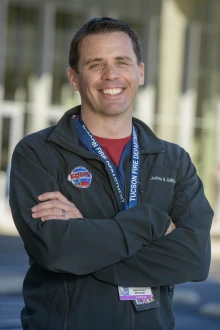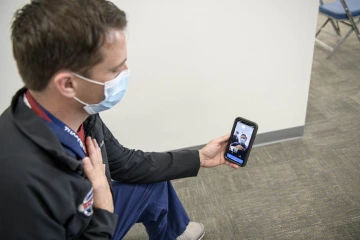Rural Health Initiative Improves Access to Emergency Care
Arizona Rural EMS Advanced Telemedicine Demonstration Initiative aims to improve patient outcomes by expanding EMS access to potentially lifesaving care.

AzREADI, a new initiative involving the University of Arizona Health Sciences and Banner – University Medical Center Tucson, utilizes a telehealth platform that gives EMS providers at the scene of an accident access to emergency department physicians to virtually receive input on the best treatment option for a patient.
The University of Arizona Health Sciences and Banner – University Medical Center Tucson recently launched a pilot project using advanced telehealth technology to enhance rural health care. The goal is to improve patient outcomes by connecting rural emergency medical services (EMS) responders to Tucson emergency medicine physicians for potentially lifesaving consultations.

Joshua Gaither, MD, is an associate professor and EMS Fellowship director in the Department of Emergency Medicine.
“Having the AzREADI resource available gives our crews a very near ‘in-person’ medical support experience,” said Richard Johnson, deputy chief of the Rio Rico Medical and Fire District, one of two partner EMS agencies participating in the pilot program. “The ability for them to contact a physician and, via the technology, hear the medical recommendation is a great comfort to me as a supervisor, knowing that my personnel are supported to that extent regardless of their location.”
The Arizona Rural EMS Advanced Telemedicine Demonstration Initiative (AzREADI) is funded by a Health Resources and Services Administration (HRSA) grant awarded to the UArizona Center for Rural Health at the Mel and Enid Zuckerman College of Public Health.
“With the technology resources provided by AzREADI, we now have the ability to share vital clinical information with doctors in real time, which makes for more effective decision making and ensures that patients get the best care while allowing us to maximize our resources,” said Marc Meredith, acting operations chief of the Sonoita-Elgin Fire District, the second participating agency in the pilot program.
Improving patient outcomes
Through AzREADI, rural EMS responders have 24/7 access to real-time consultations with board-certified EMS physicians, thanks to improvements in wireless broadband capabilities. The use of telemedicine services is vital in rural areas, where the COVID-19 pandemic has stressed already limited resources.

AzREADI will allow emergency department physicians in Tucson to make a diagnosis, recommend a transfer or prepare the medical equipment necessary to treat the patient upon arrival, all via a dedicated telehealth platform.
“EMS vehicles are being equipped with broadband cellular connection and high-speed internet access to the Banner – University Medical Center Tucson Emergency Department, making it much easier for an emergency department physician to immediately access the information, make a diagnosis, recommend a transfer or prepare the medical equipment necessary to treat the patient upon arrival,” said Joshua Gaither, MD, associate professor and EMS Fellowship director in the College of Medicine – Tucson’s Department of Emergency Medicine.
The two rural EMS agencies participating in the pilot program serve areas that include nearly 20,000 Arizonans and span 792 square miles in southern Arizona.
“EMS providers can use the AzREADI telehealth platform at the scene of the accident or illness or en route to a medical facility to virtually receive additional input on the best treatment option for the patient,” said co-investigator Amber Rice, MD, an assistant professor in the Department of Emergency Medicine who also serves as medical director for two Tucson fire departments. “The anticipated effects are better triaging, advanced onsite care, and referrals to facilities that could best meet the patient’s needs.”
Photo Gallery: Telehealth Connects Rural EMS Providers with Physicians

